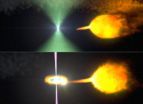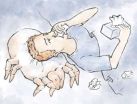(Press-News.org) VIDEO:
Zoom into an artist's rendering of AY Sextantis, a binary star system whose pulsar switched from radio emissions to high-energy gamma rays in 2013. This transition likely means the pulsar's...
Click here for more information.
In late June 2013, an exceptional binary containing a rapidly spinning neutron star underwent a dramatic change in behavior never before observed. The pulsar's radio beacon vanished, while at the same time the system brightened fivefold in gamma rays, the most powerful form of light, according to measurements by NASA's Fermi Gamma-ray Space Telescope.
"It's almost as if someone flipped a switch, morphing the system from a lower-energy state to a higher-energy one," said Benjamin Stappers, an astrophysicist at the University of Manchester, England, who led an international effort to understand this striking transformation. "The change appears to reflect an erratic interaction between the pulsar and its companion, one that allows us an opportunity to explore a rare transitional phase in the life of this binary."
A binary consists of two stars orbiting around their common center of mass. This system, known as AY Sextantis, is located about 4,400 light-years away in the constellation Sextans. It pairs a 1.7-millisecond pulsar named PSR J1023+0038 -- J1023 for short -- with a star containing about one-fifth the mass of the sun. The stars complete an orbit in only 4.8 hours, which places them so close together that the pulsar will gradually evaporate its companion.
When a massive star collapses and explodes as a supernova, its crushed core may survive as a compact remnant called a neutron star or pulsar, an object squeezing more mass than the sun's into a sphere no larger than Washington, D.C. Young isolated neutron stars rotate tens of times each second and generate beams of radio, visible light, X-rays and gamma rays that astronomers observe as pulses whenever the beams sweep past Earth. Pulsars also generate powerful outflows, or "winds," of high-energy particles moving near the speed of light. The power for all this comes from the pulsar's rapidly spinning magnetic field, and over time, as the pulsars wind down, these emissions fade.
More than 30 years ago, astronomers discovered another type of pulsar revolving in 10 milliseconds or less, reaching rotational speeds up to 43,000 rpm. While young pulsars usually appear in isolation, more than half of millisecond pulsars occur in binary systems, which suggested an explanation for their rapid spin.
"Astronomers have long suspected millisecond pulsars were spun up through the transfer and accumulation of matter from their companion stars, so we often refer to them as recycled pulsars," explained Anne Archibald, a postdoctoral researcher at the Netherlands Institute for Radio Astronomy (ASTRON) in Dwingeloo who discovered J1023 in 2007.
During the initial mass-transfer stage, the system would qualify as a low-mass X-ray binary, with a slower-spinning neutron star emitting X-ray pulses as hot gas raced toward its surface. A billion years later, when the flow of matter comes to a halt, the system would be classified as a spun-up millisecond pulsar with radio emissions powered by a rapidly rotating magnetic field.
To better understand J1023's spin and orbital evolution, the system was regularly monitored in radio using the Lovell Telescope in the United Kingdom and the Westerbork Synthesis Radio Telescope in the Netherlands. These observations revealed that the pulsar's radio signal had turned off and prompted the search for an associated change in its gamma-ray properties.
A few months before this, astronomers found a much more distant system that flipped between radio and X-ray states in a matter of weeks. Located in M28, a globular star cluster about 19,000 light-years away, a pulsar known as PSR J1824-2452I underwent an X-ray outburst in March and April 2013. As the X-ray emission dimmed in early May, the pulsar's radio beam emerged.
While J1023 reached much higher energies and is considerably closer, both binaries are otherwise quite similar. What's happening, astronomers say, are the last sputtering throes of the spin-up process for these pulsars.
In J1023, the stars are close enough that a stream of gas flows from the sun-like star toward the pulsar. The pulsar's rapid rotation and intense magnetic field are responsible for both the radio beam and its powerful pulsar wind. When the radio beam is detectable, the pulsar wind holds back the companion's gas stream, preventing it from approaching too closely. But now and then the stream surges, pushing its way closer to the pulsar and establishing an accretion disk.
Gas in the disk becomes compressed and heated, reaching temperatures hot enough to emit X-rays. Next, material along the inner edge of the disk quickly loses orbital energy and descends toward the pulsar. When it falls to an altitude of about 50 miles (80 km), processes involved in creating the radio beam are either shut down or, more likely, obscured.
The inner edge of the disk probably fluctuates considerably at this altitude. Some of it may become accelerated outward at nearly the speed of light, forming dual particle jets firing in opposite directions -- a phenomenon more typically associated with accreting black holes. Shock waves within and along the periphery of these jets are a likely source of the bright gamma-ray emission detected by Fermi.
The findings were published in the July 20 edition of The Astrophysical Journal. The team reports that J1023 is the first example of a transient, compact, low-mass gamma-ray binary ever seen. The researchers anticipate that the system will serve as a unique laboratory for understanding how millisecond pulsars form and for studying the details of how accretion takes place on neutron stars.
"So far, Fermi has increased the number of known gamma-ray pulsars by about 20 times and doubled the number of millisecond pulsars within in our galaxy," said Julie McEnery, the project scientist for the mission at NASA's Goddard Space Flight Center in Greenbelt, Maryland. "Fermi continues to be an amazing engine for pulsar discoveries."
INFORMATION: END
NASA's Fermi finds a 'Transformer' pulsar
2014-07-22
ELSE PRESS RELEASES FROM THIS DATE:
Forty-five percent rise in diagnostic imaging tests by GPs -- new study
2014-07-22
A 45 per cent rise in diagnostic imaging tests ordered by Australian GPs is being driven by increasing GP visits, a rising number of problems managed at consultations and a higher likelihood that GPs order imaging tests for these problems, according to a new University of Sydney study released today.
Based on a long term national survey of 9,802 GPs between 2002 and 2012, the report draws on data from more than 980,000 GP-patient encounter records to assess the extent to which GP's order tests in line with diagnostic imaging guidelines.
"Most imaging tests ordered by ...
Gene variant identified as a heart disease risk factor for women
2014-07-22
When it comes to heart disease, Dr. Ross Feldman says women are often in the dark. Historically, it was thought that heart disease was a men's-only disease, however, data has shown that post-menopausal women are just as likely as men to get heart disease and are less likely to be adequately diagnosed and treated. New research from Western University published online this week in the British Journal of Clinical Pharmacology brings to light a genetic basis for heart disease in women and helps to identify which women are more prone to heart disease.
The study, led by Dr. ...
Researchers create vaccine for dust-mite allergies
2014-07-22
If you're allergic to dust mites (and chances are you are), help may be on the way.
Researchers at the University of Iowa have developed a vaccine that can combat dust-mite allergies by naturally switching the body's immune response. In animal tests, the nano-sized vaccine package lowered lung inflammation by 83 percent despite repeated exposure to the allergens, according to the paper, published in the AAPS (American Association of Pharmaceutical Scientists) Journal. One big reason why it works, the researchers contend, is because the vaccine package contains a booster ...
Activity level may predict orthopedic outcomes
2014-07-22
According to a literature review in the July issue of the Journal of the American Academy of Orthopaedic Surgeons (JAAOS), patients' activity level is a strong predictor for how well they will do with certain treatments and how well they recover from injuries after treatment. Patients are encouraged to ask their orthopaedic surgeon if activity level is an important factor in their treatment decision. For example, more active patients are at a higher risk of re-injury after an anterior cruciate ligament (ACL) reconstruction, and activity level should be considered when deciding ...
UI study finds potential genetic link between epilepsy and neurodegenerative disorders
2014-07-22
A recent scientific discovery showed that mutations in prickle genes cause epilepsy, which in humans is a brain disorder characterized by repeated seizures over time. However, the mechanism responsible for generating prickle-associated seizures was unknown.
A new University of Iowa study, published online July 14 in the Proceedings of the National Academy of Sciences, reveals a novel pathway in the pathophysiology of epilepsy. UI researchers have identified the basic cellular mechanism that goes awry in prickle mutant flies, leading to the epilepsy-like seizures.
"This ...
Death of a parent during childhood is associated with greater mortality in early adulthood
2014-07-22
Experiencing the loss of a parent during childhood or adolescence is associated with a greater risk of mortality, according to a study published in this week's PLOS Medicine. The study, conducted by Jiong Li and colleagues from Aarhus University in Denmark, finds that individuals who lost either a mother or a father during childhood had a greater risk of mortality in the years following the parent's death compared with people unaffected by parental death during childhood.
The researchers reached these conclusions combining data from national registries from all children ...
Distinctive developmental origin for a drainage tube in the eye
2014-07-22
A Jackson Laboratory based research team has conducted a comprehensive exploration of an eye structure known as Schlemm's canal: a key gatekeeper for the proper flow of eye fluid, presenting a number of insights relevant to glaucoma and other diseases.
For the study publishing July 22 in the Open Access journal PLOS Biology, the researchers at JAX and Tufts University School of Medicine in Boston developed a new, "whole-mount," three-dimensional approach to analyse mouse models that have been engineered to host fluorescent proteins, to determine how Schlemm's canal forms ...
New research finds pathogenic connection between autoimmune disorders and cancer
2014-07-22
WASHINGTON -- Autoimmune disorders may share certain pathogenic mechanisms with cancer, according to a new report by George Washington University (GW) researcher Linda Kusner, Ph.D., published in PLOS ONE on July 22.
This paradigm shifting work shows that the very same inhibitors of apoptosis, or cell destruction, in tumors are also expressed in cells that produce autoimmune diseases. Henry Kaminski, M.D., chair of the Department of Neurology at the GW School of Medicine and Health Sciences (SMHS), as well as colleagues from the Roswell Park Cancer Institute, collaborated ...
NASA provides double vision on Typhoon Matmo
2014-07-22
Two instruments aboard NASA's Aqua satellite provided different views of Typhoon Matmo on its approach to Taiwan today, July 22.
The Moderate Resolution Imaging Spectroradiometer or MODIS instrument snapped a visible picture of Typhoon Matmo's clouds on July 22 at 1:10 a.m. EDT. The MODIS image showed a center obscured by clouds. Bands of thunderstorms wrapped tightly into the center of circulation, creating the signature comma shape of a mature tropical cyclone. At the time of the image, the center was southeast of the southeastern tip of Taiwan. The image also showed ...
Carlton Fire Complex, Washington -- July 22, 2014
2014-07-22
The Carlton Complex fires started on July 14, 2014, by lightning from a weather system that moved through the Methow Valley. The Carlton Complex consists of four fires: Stokes Fire, Gold Hikes Fire, French Creek Fire and the Cougar Flat. The Stokes and Gold Hikes fires are now one larger fire. The fires are burning in timber and grass and the area burning is currently over 243,000 acres in size. The present fire situation continues to rapidly change due to the high fire danger. Public and firefighter safety is the priority on the Carlton Complex fires. Thirty-five primary ...





